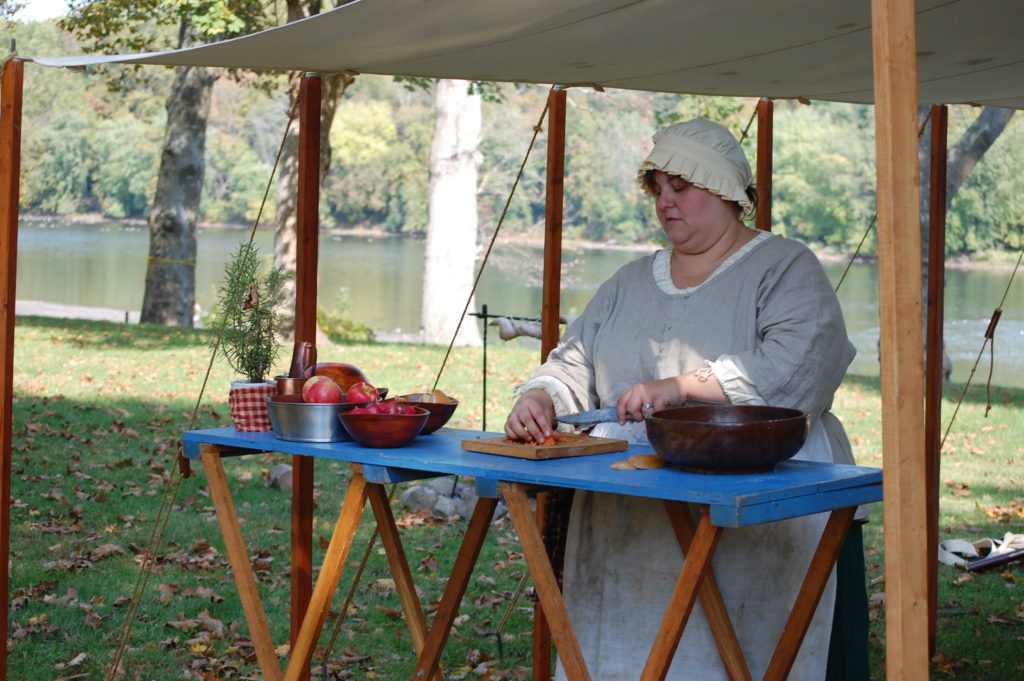
Long-term food storage was critical to the 18th-century household. During the colonial era, the coming of autumn did not just mean changing leaves and cooler temperatures: it was also time to preserve the harvest.
Fresh produce could only be enjoyed during the growing season, so colonists would intentionally grow an overabundance of food and then preserve their harvest for consumption during the winter. Produce was continuously preserved as it came into season, and whatever was not eaten was preserved for future use.
Depending on the type of food—fruits, vegetables, meat, or dairy—colonists used a variety of different techniques.
Drying
For fruit, vegetables, and herbs, drying was the easiest method. Apples, peaches, pumpkins, beans, and berries were readily available and often preserved through this process.
Produce was dried by laying it out on a clean surface in a sunny area and covering it with a fine weave cloth to keep insects away. Using the sun to draw out moisture from these items made them less susceptible to mold and helped them last well into the winter.
Several cookbooks also mention drying fruit in a “slack” – or cool – oven. After the baking was finished, the cook would lay the fruit on pans in the oven as it was cooling down, leaving the fruit in there overnight to dry.
Pickling
Pickling was another method of preserving produce. Vegetables and even eggs would be put in glazed crocks, soaked with vinegar, and covered with either leather, clarified butter, or a pig bladder, which would stretch and act like plastic wrap. The highly acidic environment created by the vinegar protected the vegetables from spoiling.
For instance, sauerkraut was an especially popular type of fermented pickle. By packing the cabbage in vinegar, the fermenting process would release vitamin C, a known cure for scurvy.
Eighteenth-century cookbooks detail pickling for every vegetable imaginable – even marigold flowers were pickled for decoration on porridge.
Sugaring
Fruits were often preserved using a technique known as sugaring. A variety of fruit packed in a heavy syrup would keep for months. If the top layer of syrup gathered mold, it would be scraped off and the fruit would be scooped out. Although this method can be traced to the 14th century, it wasn’t until the 18th century that it became less costly and readily available to the average colonial household.
Meat & Dairy
Since most colonial diets were protein-based, meat smoked in fall would be consumed during the winter. Colonists could also supplement with fresh meat, which could be kept cold by hanging in their unheated attics or by putting the meat on ice for the short-term.
Another process used to preserve meet was known as salting. The meat was rubbed with salt, placed it in wooden barrels and topped off with water, making a brine. The brine kept the meat moister and more palatable than drying, and it prohibited the growth of harmful organisms.
Making butter was a common way to preserve milk. The cream that rose to the top of the fresh milk would be churned, resulting in the fat globules separating from the buttermilk. The mixture would be kneaded and washed until all the buttermilk was removed. Even the poorest of families with only one cow would churn butter to save milk, and many household inventories would include churns, milk pans and butter paddles.
Cold Storage
Although ice boxes and ice houses were not widely used during the colonial era, they did emerge during the early 19th century as a form of temporary food storage. Ice houses could store foods for longer periods of time, but they would not preserve food as long as food that had been pickled or dried.
You can see an example of a large ice house at Washington Crossing Historic Park. “While visiting the park, you may notice an octagonal structure located at the side of McConkey’s Ferry Inn. This is our ice house, an addition to the tavern around the year 1820,” explains historical interpreter Connie Unangst. “Ice was largely used in the short term to keep food, such as oysters, from spoiling before serving them in the tavern.”
The ice house at McConkey’s Ferry Inn is too large for tavern use alone. It was likely also used for temporary food storage for Mahlon Taylor’s wholesale business.

